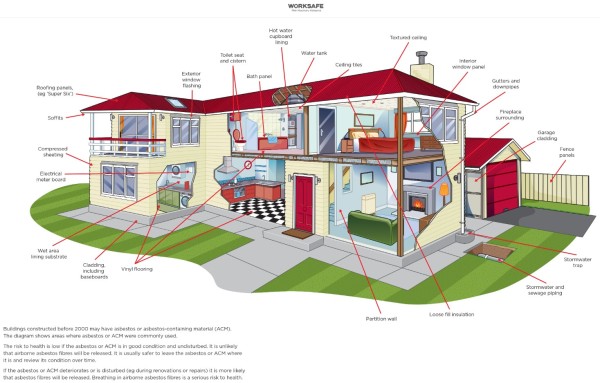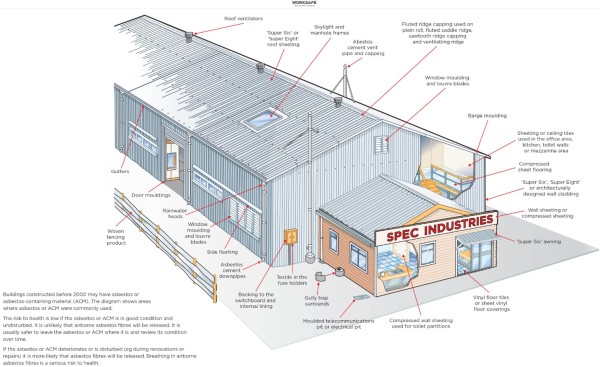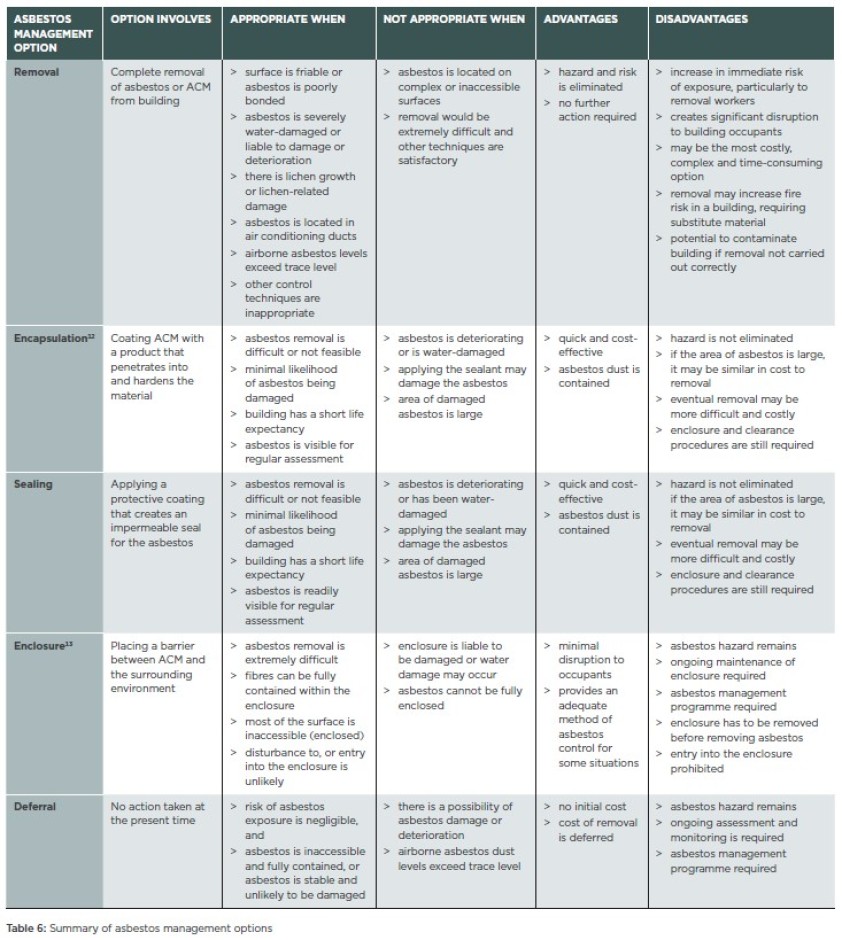-
What makes asbestos dangerous?
Asbestos fibres are released into the air when people handle asbestos-containing materials with poor safety procedures. Asbestos fibres are around 50 to 200 times thinner than human hair, can be invisible and can be breathed in easily. They can become trapped deep in your lungs and cause damage over a long time.
The two asbestos-containing material groups include:
- Bonded (non-friable) asbestos materials are made up of a bonding agent (such as cement) with asbestos fibres added. They usually contain less than 15 per cent of asbestos and normally do not release fibres unless they are disturbed, damaged or have deteriorated over time.
- Friable (loosely bound) asbestos materials are those which can be crumbled or reduced to powder by hand. Bonded asbestos can become friable if severely fire-damaged or crusted. Friable asbestos materials are the most dangerous as the fibres can be released into the air.
The Asbestos Regulations apply to those organisations working with asbestos and businesses that manage or control workplaces. The regulations also apply to landlords.
To assist businesses in meeting their obligations, WorkSafe has published an Approved Code of Practice: Management and Removal of Asbestos, and Good Practice Guidelines: Conducting Asbestos Surveys.
-
Asbestos Management Policy
Policy
The Methodist Church owns many properties and buildings that are highly likely to include asbestos-containing materials.
The Church recognises that we have an ethical, moral, spiritual and legal requirement to do our utmost to manage the inherent and long term risk asbestos poses to Our People ā Tātou Tāngata.
As such, the risk of asbestos in every Methodist owned or occupied building must be actively managed until there is no asbestos present.
Why we need to manage asbestos
In 2010, asbestos was the number one workplace killer in New Zealand, with 170 people dying from asbestos-related diseases that year. All types of asbestos can cause asbestos-related disease, and most asbestos-related illnesses take around 20 years before symptoms start to show.
WorkSafe NZ introduced the Asbestos Regulations 2016 as part of the Health and Safety at Work Act 2015 (page 2, number 42 Asbestos Management Policy). These regulations provide a methodical approach to asbestos management and working with asbestos.
Rationale
A consistent Asbestos Management Approach will allow the Church to maintain a central registry of asbestos-containing properties, which includes information on what is being done in each property to manage the asbestos risk.
Document disclaimer
This document relates to the management work wrapped around identifying and planning what to do with asbestos.
This document excludes guidance for any work related to actually working with asbestos (removal, sealing, encapsulating, or otherwise controlling). Only qualified professionals should undertake asbestos-related building works contracts.
-
Asbestos Risk
Highest Risk
Asbestos is most risky (and therefore a current risk) when it is friable and/or when it is airborne, generally a dust.
Therefore, if a building surface is breaking down and unstable, or if you are about to undertake work (demolition work or refurbishments) that involves making dust, you must ensure that asbestos is absent.
Risk Triggers
Use these risk triggers to guide what level of urgency is needed within your Asbestos Management Plan (AMP) actions.
If you don't know if asbestos is present... then the risk... and you should... and the building surface is breaking down and unstable may be immediate immediately identify if asbestos and you are about to undertake demolition, refurbishment or excavation work will be created by you confirm if asbestos is present or not using formal identification methods before any work starts but the building surface is sound is not immediate create an AMP to ensure asbestos risk remains low, then tie in long term controls (i.e. formal asbestos identification and removal) with other building works. Building categories
Category Asbestos present? Risk Level? Action 1 No None No problem - end of story 2 Yes and/or suspected Does not present a current risk Keep people informed to ensure it does not become a current risk 3 Yes and/or suspected Presents a current risk Remove the risk (turn the building into category 1 or 2) Ideally, all buildings will become Category 1, and there will be no Category 3 buildings.
-
Asbestos free in stages

Stages
Asbestos Management Plan provides the general baseline of the asbestos status of the building.
Demolition/Refurbishment Asbestos Surveys provide specific verification of the asbestos status in the areas that are going to be demolished or refurbished.
Clearance Certificates are issued once identified asbestos has been fully removed.
If there is a chance your building may have asbestos in it, you must have an asbestos management plan.
Each area you work on must either have a “No Asbestos” demolition/refurbishment asbestos survey or a clearance certificate.
Repeat until your entire building is certified as asbestos free.
Asbestos Management Plans
-
What are they
An asbestos management plan sets out where any identified asbestos or asbestos-containing material is present and how it will be managed.
It should only be used for planning purposes as it may contain assumptions of the presence of asbestos. Surface tests may be taken, but testing is generally non-intrusive.
A copy of the plan should be kept with the building and should be accessible to contractors and other workers.
-
MCNZ Asbestos Management Plan
Where to find it
See Bricks and Mortar Appendix 5 for a basic Asbestos Management Plan
- Pages 1 and 2 – information about the building and building users
- Pages 3 and 4 – information for workers and visitors coming on site
What it does
- Provides a basic statement of We don’t know, so we won’t touch.
- Provides an easy, no-cost approach that anyone can do.
- Gathers basic building details, which consultants would also need for their management plans.
When to use it
As soon as possible
-
Consultant's Asbestos Management Plan
What it does
Consultants have the experience and knowledge to create more in-depth asbestos management plans than the MCNZ version, including laboratory testing of easy-access, potentially asbestos-containing materials.
It is only a planning tool; a demolition/refurbishment survey is still required before any work is carried out to suspect asbestos areas
Where to get one
- Check out the internet or Yellow Pages for consultants in your area, or
- contact [E-Mail not displayed] for assistance.
How much will it cost
It depends on the size and intricacy of your building. Good consultants should be able to provide a quote first. Budget for at least $2,000 and be prepared for more.
It should include
- Areas inspected / not inspected
- Diagrams of where tests were taken from and what tests were positive or negative for asbestos
- Photos of where the tests were taken from
- Details of the tested material
- Details of the materials assumed to contain asbestos
- Recommended controls for confirmed asbestos-containing materials
MCNZ’s preference is for asbestos removal. Encapsulation, sealing and enclosure should always be avoided where possible.
-
Demolition/Refurbishment Asbestos Surveys
What are they
These surveys provide a definitive ‘does contain/ does not contain’ asbestos status to all materials in the building areas that are to have work carried.
The testing process may be intrusive to test hidden materials such as insulation, plaster covered with paint, paint, and inbuilt window or door seals, etc.
Where to get one
- Check out the yellow pages for asbestos consultants in your area, or
- contact [E-Mail not displayed] for assistance.
It should include
- Areas inspected / not inspected
- Diagrams of where tests were taken from, and what tests were positive or negative for asbestos
- Photos of where the tests were taken from
- Details of the tested material
- Details of the materials assumed to contact asbestos
- Recommended controls for confirmed asbestos containing asbestos
Work should only be undertaken with either a demolition/refurbishment survey or a clearance certificate available for that area.
It is our responsibility to ensure all contractors and workers know the asbestos status of the building materials that they work with or on.
-
General
Communicate, cooperate, coordinate
Communicate asbestos risk with everyone who uses the building.
Ensure everyone participates to avoid activating the asbestos risk.
Your assessments and controls need to be shared with:
- everyone who works and/or lives at the property
- contractors and visitors and anyone else who is not full time at the property.
Consider using signage in appropriate places (next to or on the area or plant that potentially contains asbestos) to warn people of the risk.
There are ways to tell Others
- H & S book
- Sign in book
- Contractor sign up/induction
- Signs/labels (next to Building Warrant of Fitness etc)
- Property committee processes (property inspections etc)
Record keeping
Records should list all identified or assumed asbestos in a workplace that presents,or is likely to present, a risk of exposure to breathable asbestos fibres.
From the records it should be easy to see what is or is not yet cleared of asbestos.
Asbestos records should be kept for the life of the building, or as long as the Methodist Church owns the building.
What records should include
Records should describe all identified asbestos in the workplace, or likely to be in the workplace occasionally, including:
- Asbestos Management Plan
- floor plan/s
- all demolition/renovation asbestos surveys
- all clearance certificates
- analysis results confirming whether a material at the workplace is or is not asbestos
- dates when the identification/inspections occurred
- photographs or drawings are useful to show the location of asbestos
Records availability
Records should be kept available for people that may be at risk from the asbestos: staff, visitors, contractors, future project workers.
Location Examples
Pictorial examples follow of where asbestos may have been used; it could be anywhere.
Risk assessment and controls
WorkSafe has provided a table of options and assessment criteria which will be used in the Asbestos Management Plan.
This table of asbestos management options follows the asbestos locations pictorial examples.
-
Potential asbestos locations in a pre-2000 house
-
Potential asbestos locations in a commercial building
-
Asbestos Management Options
-
Project Works - demolition, rebuild, renovation, refurbishment
Project work process
Knowing early if a building contains asbestos or not will allow for more accurate planning of a project regarding the scope and budget.

Project Steps
The following steps should be undertaken once project work is planned, but before project work starts.
Step Activity 1. Test for asbestos The project area should be thoroughly surveyed, with samples taken for laboratory testing as part of a demolition/refurbishment survey.
Allow time for survey results to come through before deciding on a project start date.
2a. Test results: No asbestos - Add survey results to main asbestos management plan.
- Project works continues as per normal.
2b. Test results: asbestos present - Add survey results to main asbestos management plan
- Allow contingencies (or get firm quotes from certified/qualified companies) in your project plan for asbestos removal.
3. Asbestos records - During the project works the original asbestos assumptions and the analysis results must be made available for all site workers to see.
- The post-removal air test. All clear results are particularly important to display.
- Copies of key documents should be copied to the AMP.
- WorkSafe notification.
- close out certificate.
- final air test.
Inform MCPC
Ensure MCPC has a copy of your asbestos records or email them through to [E-Mail not displayed]
-
Reference Material
Further reference material
This table provides further useful WorkSafe NZ reference material.
WorkSafe NZ Document
Description / Download Location
Approved Code of Practice: Management and removal of asbestos
The code is comprehensive and covers all aspects of managing asbestos safely in NZ workplaces.
Guidelines for PCBUs conducting asbestos surveys, workers carrying out asbestos surveys and PCBUs that need to identify asbestos in a workplace.
Do you need an Asbestos Management Plan?
You have a duty to have an Asbestos Management Plan in place for your buildings and workplaces where asbestos is likely to be found.
Clarifying the difference as used in the Asbestos Regulations 2016.
Contact [E-Mail not displayed] if you have any queries.
|
Related Links |
| Asbestos Articles |
| Asbestos Webinar Aug 2021 |
| WorkSafe asbestos documents |
|
Different ideas if you don't have a floor plan already |




